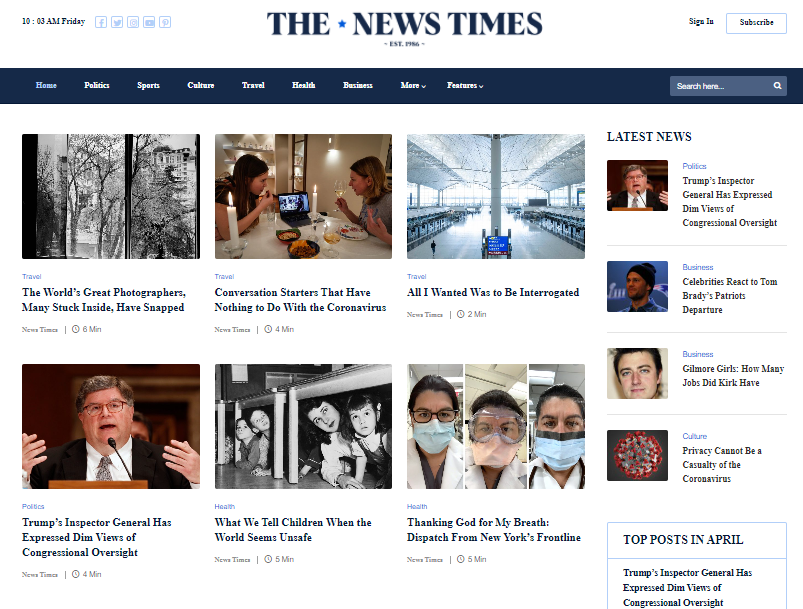FAQs About stnews.live Answered
The Influence of Social Network on the Method We Consume News Online
Social media site has actually essentially changed news consumption. It gives immediate access to information, commonly eclipsing conventional media outlets. However, this fast dissemination includes challenges. Individuals deal with the risk of encountering false information and ending up being entraped in echo chambers. The formulas driving individualized content can cover varied viewpoints. As these dynamics advance, understanding their ramifications ends up being crucial for educated engagement in public discourse. What approaches might aid browse this complicated landscape?
The Development of News Intake in the Digital Age
As modern technology advanced, the means people taken in news changed significantly in the electronic age (stnews.live). Typical papers and broadcast media started to decrease as the internet became a primary resource of details. On-line systems offered immediate access to news short articles, videos, and podcasts, allowing customers to remain notified at any time. The comfort of mobile devices better increased this change, allowing individuals to get updates on the move
In addition, the increase of news collectors and internet sites facilitated the intake of diverse point of views, equipping individuals to tailor their news intake based upon personal rate of interests. This development also prompted news organizations to adapt their methods, concentrating on digital web content and appealing viewers through multimedia styles. As an outcome, the conventional obstacles of time and room in news distribution decreased, leading to an extra prompt and individualized news experience for target markets worldwide.
The Duty of Social Network Platforms in News Distribution
Social media site platforms have transformed news distribution by giving immediate accessibility to info. Their algorithm-driven content curation frequently prioritizes involvement over accuracy, causing substantial reliability difficulties (stnews.live). As users navigate this landscape, the ramifications for news usage and public discourse come to be significantly intricate
Instant News Access
Standard news outlets have long been the primary resource of info, the surge of social media platforms has actually substantially transformed how news is accessed and taken in. Instantaneous news gain access to has become a trademark of the electronic age, allowing users to obtain updates in real time. Platforms such as Twitter, Facebook, and Instagram permit news to spread swiftly, typically exceeding traditional media in rate and reach. Customers can share stories, remark on events, and involve with reporters, creating a vibrant communication between the audience and news content. This immediacy fosters a society of necessity, prompting users to look for details promptly. Consequently, the expectation for prompt news has reshaped journalistic practices, engaging wire service to adjust their techniques to satisfy the demands of a fast-paced electronic setting.
Algorithm-Driven Content
While customers proactively involve with content on social media, the algorithms that govern these platforms play a crucial function in establishing which newspaper article gain exposure. These algorithms analyze individual behavior, preferences, and interaction metrics to curate tailored news feeds. Consequently, particular stories might be intensified while others continue to be rare, often focusing on thrilling or trending topics over substantive reporting. This selective direct exposure shapes customers' assumptions of current occasions and influences public discourse. The dependence on algorithm-driven web content can develop resemble chambers, where individuals are generally subjected to perspectives that straighten with their very own ideas. The dynamics of news distribution on social media platforms greatly impact how individuals take in and translate info in the digital age.
Integrity Difficulties
As individuals significantly turn to social media for news, the trustworthiness of info run into on these platforms becomes a pressing concern. The decentralized nature of social media allows anyone to release web content, typically obscuring the lines in between trustworthy journalism and misinformation. Algorithms focus on involvement over precision, leading to the widespread circulation of marvelous or misleading tales. This environment postures substantial obstacles for users trying to recognize credible resources. Social media site platforms, while endeavoring to combat misinformation with fact-checking and web content moderation, run the gauntlet for incongruities and prejudices in their approaches. Ultimately, the duty exists with individuals to critically evaluate the news they take in, as the rapid spread of info typically outpaces verification initiatives by platforms.
The Surge of Resident Journalism and User-Generated Material
The surge of resident journalism has actually equipped daily people to share news and viewpoints, commonly supplying insights that typical media might neglect. This shift likewise presents considerable challenges, specifically the spread of misinformation that can arise from unproven content. As user-generated content becomes more prevalent, the equilibrium in between authentic voices and accuracy in coverage continues to be a crucial issue.
Encouraging Day-to-day Voices

Difficulties of Misinformation
While the surge of resident journalism has opened methods for diverse voices in the media landscape, it has actually also introduced substantial difficulties connected to misinformation. The simplicity of sharing information via social media sites platforms enables people to disseminate news swiftly, however this fast spread frequently comes with the cost of precision. User-generated web content regularly does not have the extensive fact-checking and editorial oversight that standard journalism offers. Sensationalized or incorrect stories can obtain traction, misleading target markets and shaping public assumption. Additionally, the blending of opinion and truth within social media complicates the difference between trustworthy info and false information. Because of this, consumers have to navigate a progressively complex media atmosphere, needing vital thinking skills to discern reliable news sources among the noise

False information and Its Effects for Public Discussion
As social networks platforms progressively control the landscape of details circulation, the expansion of false information presents substantial obstacles for public discussion. False information, often created to misguide or prompt emotional reactions, can misshape perceptions of fact and threaten depend on in reliable sources. This sensation leads to polarized why not look here point of views, as individuals gravitate in the direction of echo chambers that enhance their ideas, further entrenching departments within society.
The effects for public discourse are extensive. When citizens depend on false info, purposeful dialogue reduces, and the democratic procedure suffers. Misinformation can prompt worry and confusion, impacting public wellness, security, and political stability. Therefore, fostering media proficiency becomes necessary, equipping people to seriously examine information and recognize reality from fiction. Attending to the obstacles presented by misinformation is crucial for maintaining the integrity of public discussion and guaranteeing an educated people capable of involving in useful discussions.
The Impact of Formulas on News Presence
Provided the central duty of formulas in identifying content exposure, their influence on news usage is profound. These formulas, utilized by social media sites systems, prioritize specific sorts of material based upon customer engagement and preferences. As an outcome, newspaper article that align with preferred trends or audience rate of interests are more probable to be presented prominently, while much less marvelous tales might be overlooked. This produces a setting where individuals are revealed mainly to information that enhances their viewpoints, potentially bring about resemble chambers.
Additionally, the consistent advancement of formulas suggests that news organizations must adjust their strategies to align with these altering criteria, typically focusing on clickbait or psychologically billed headlines. The stability of news coverage can be compromised, as crucial stories might not get the visibility they deserve. The algorithmic shaping of news visibility therefore plays an her response important function in affecting public understanding and understanding of current events.
The Shift Towards Visual Storytelling in News Media
Significantly, news media is welcoming aesthetic storytelling as a powerful device to involve audiences. This approach leverages photos, video clips, infographics, and interactive elements to convey information extra effectively than traditional text-based layouts. As interest spans shorten, visuals use a fast, impactful method to connect complicated stories and get hold of audiences' rate of interest.
Systems like Instagram and TikTok have additional accelerated this trend, compelling news organizations to adjust their content methods to fit these visually-driven atmospheres. By including compelling visuals, news electrical outlets can improve emotional links and foster higher understanding of topical problems.
Additionally, aesthetic storytelling enables more varied narratives, showcasing several perspectives through vibrant presentations. As target markets increasingly take in news via mobile devices, the change toward visuals not just caters to user choices however likewise assists to break down barriers to details gain access to. Eventually, this evolution shows a more comprehensive makeover in exactly how news is produced and consumed in the electronic age.
Future Patterns: Navigating the Changing Landscape of News Intake
While the electronic landscape remains to advance, news intake is poised for considerable makeover driven by emerging technologies and changing audience habits. As expert system and machine knowing breakthrough, personalized news feeds will certainly come to be a lot more common, enabling customers to receive material tailored to their passions. This modification can cause greater interaction yet additionally elevate problems regarding echo chambers and false information.
The increase of voice-activated tools and smart audio speakers will certainly affect just how news is provided, shifting the focus from aesthetic to acoustic styles. This trend may encourage news organizations to take on more succinct and engaging audio web content.

Often Asked Concerns
Exactly How Do Social Media Site Interactions Affect News Reputation?
Social network communications can significantly affect understandings of news reliability. Involvement metrics, such as sort and shares, typically form target market depend on, with prominent posts gaining regarded legitimacy, regardless of the accuracy or integrity of the information offered.
What Duty Do Influencers Play in Shaping News Narratives?
Influencers significantly shape news stories by leveraging their systems to enhance specific tales, often customizing material to their target market. This can bring about biased point of views, affecting public understanding and prioritizing sensationalism why not look here over factual reporting.
Exactly How Can Users Identify Reliable News Sources on Social Media Site?
Individuals can identify trusted news sources on social media by examining the source's trustworthiness, confirming facts through several outlets, examining the professionalism and trust of the web content, and recognizing potential biases in reporting to ensure exact information.
What Effect Does Social Media Site Have on Standard Journalism Jobs?
Social media site considerably affects standard journalism jobs by altering profits versions, reducing demand for print media, and promoting competitors from resident reporters. Consequently, numerous specialists encounter work insecurity and should adapt to rapidly altering media landscapes.
Just How Do Various Demographics Consume News on Social Media?
Different demographics exhibit varied preferences for news consumption on social media. Younger target markets favor platforms like TikTok and Instagram for fast updates, while older individuals often tend to prefer Facebook and Twitter for much more thorough conversations and short articles.